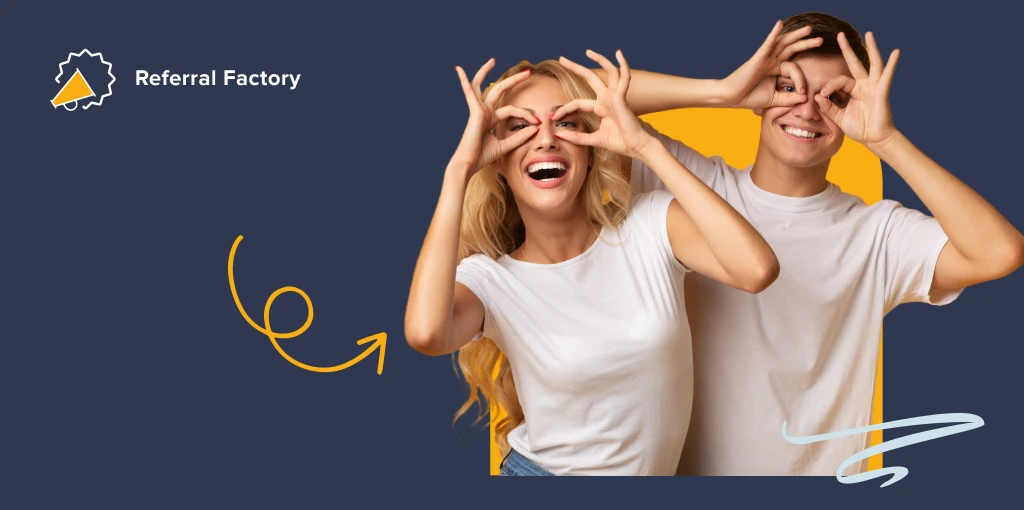What Is A Double Sided Referral Program? [With Examples]
Kirsty Sharman
Est. Reading Time: 11 Mins
Not many people know this, but one of the most cost-effective ways to boost your marketing performance is to make your happy customers… a part of your marketing team. No exaggerations!
Implementing a referral program is usually a great way to tap into the power and love of an existing customer base. After all, who knows your brand better than the people who’ve tried and tested it out?
And, if you want to make the most of a client referral program, we have one simple piece of advice – make it a double-sided referral program.
Why is this our Number 1 tip? Double-sided referral programs might just be the single most effective tactic in referral marketing.
This might sound like a strong statement, but research proves it. Over 90% of all referral programs run on Referral Factory are double-sided. Why? Because they work best. And if, on top of that, you add an effective referral software, you can expect the highest marketing results.
Let’s get deeper into this topic and learn what are some best practices for those who want to tap into the power of the double-sided referral programs.
Table of Contents
Double-Sided Referral Programs: What You Need to Know
Let’s start with the fundamentals – how does a double or two-sided referral program work? There are 3 essential steps to it:
-
- Your existing clients refer your business to their friends, family, colleagues, etc.
-
- When the friend they bring in converts (by becoming a paying customer in their own right, for example), both the person referring (i.e., your existing client) and the person invited (i.e., their friend) get rewarded. This referral reward can be anything from discounts and free trials to cash rewards and Amazon vouchers.
-
- As a result, your referral program participants get some bonuses while you acquire new customers (not just leads!) at a lower cost compared to most other marketing tactics.
To understand how the double-sided referral program works, we first have to get clear that the reward structure for your referral programs can be:
-
- Single-sided
-
- Double-sided
Now, what’s the difference between the two?
Single-sided referral programs, by default, mean that only one group of participants is incentivized. It can be either a person referring or a person invited, but in most cases, it’s the person referring. This type of referral program is common in affiliate marketing.
Double-sided referral programs, on the other hand, always reward both the person referring and the person invited. It’s a reciprocal system where everyone wins:
🧑💼 Referrers feel good about sharing their positive experiences and earn rewards for doing so.
🧑🤝🧑 Referred friends get introduced to a brand they might love and enjoy a special welcome offer.
📈 Businesses acquire new customers at a lower cost and strengthen relationships with existing ones.
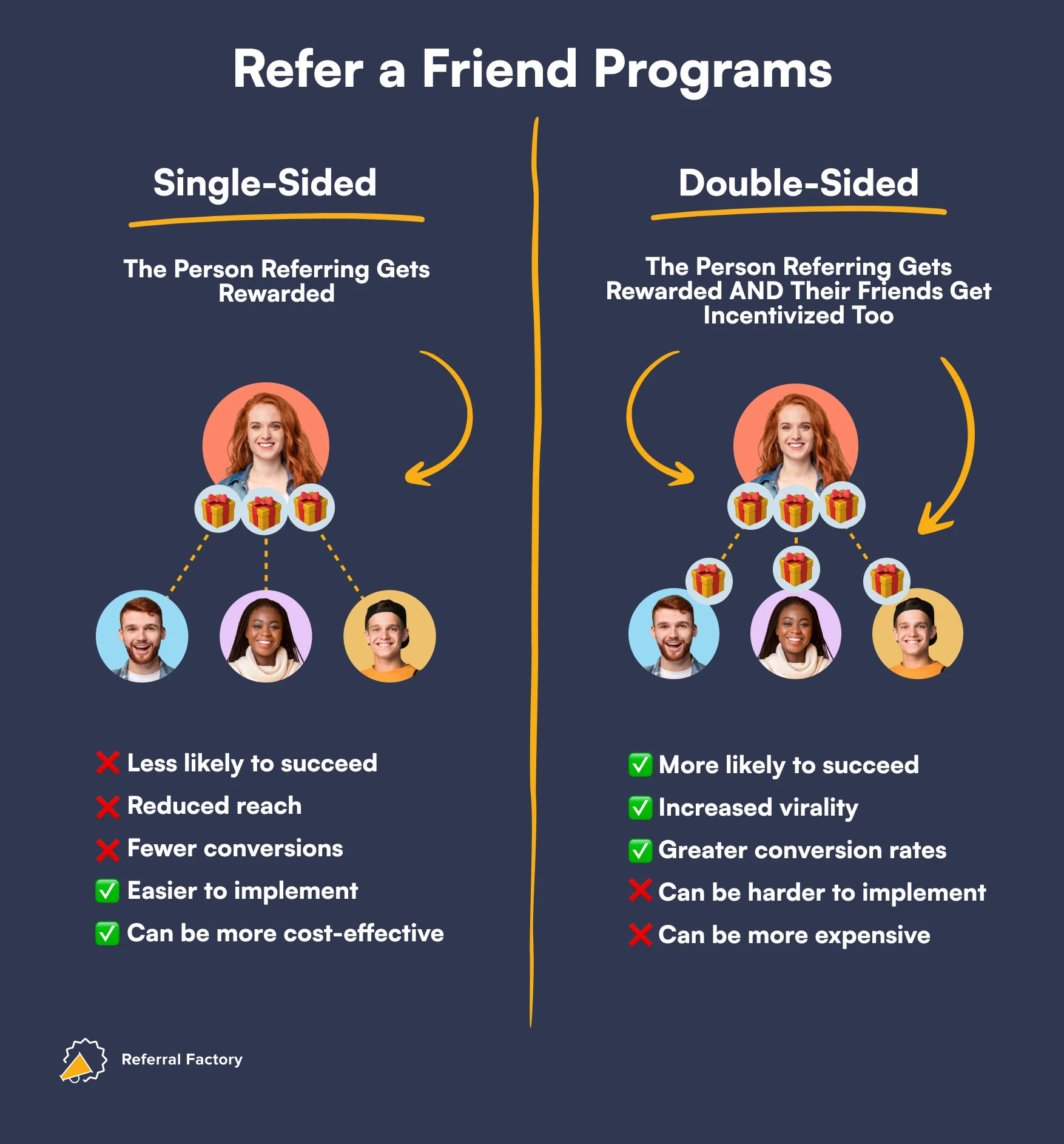
A double sided referral program is a great way to boost customers acquisition – if you’re ready to try it, then enter your website below and start building your referral program!
The Psychology Behind What Makes Double-Sided Referrals Work
Okay, so there are no doubts about the effectiveness of referral marketing. In the end, 92% of consumers rely on recommendations from the people they know (according to referral marketing statistics).
The logic is simple – if your purchase is driven by your family or friends who have tried a product or service, you are more likely to trust that company. Plus, if this business offers referral rewards, it really boosts customer loyalty.
Double-sided referral programs bring all those effects one step further. Often, this approach to rewarding holds a true secret to a successful referral.
Don’t get us wrong – single-sided campaigns are also effective. But, on average, they bring less notable results. All in all, it is understandable – one party isn’t fully incentivized, so their motivation might be weaker.
But what exactly is it about double-sided referral programs that make them better? It’s simple psychology:
Reason #1: Reciprocity Means You Give and Get
Your clients might feel a little awkward profiting off their friends, and this is especially the case when it comes to higher-ticket purchases and B2B referrals. But a double-sided reward structure means the benefit is reciprocal!
The referrer might be gaining a little something for making the referral, but they also get to share a special offer with their network.
And often, the social standing that comes with being able to give their network access to that deal is a greater motivation than the value of the reward you’re able to offer!
Reason #2: People Love Gifts
People love getting free cool stuff, right? And the best thing about the two sided referral program is that everyone gets something. That’s how the whole experience becomes more enjoyable for every participant.
An important detail to keep in mind, though, is that you have to choose the right referral rewards that are useful and relatable. For example, if you sell a seasonal product that people don’t buy regularly, giving them a discount for their next purchase won’t be too attractive. But if, instead, you give them an Amazon voucher, for instance, they might be much more excited and motivated to find a new client for your business.
Reason #3: It’s A Shared Experience
There is one especially beautiful aspect of the double-sided referral programs. When you are rewarding both parties, you create a sense of shared experience and belonging within your customer base.
This fosters loyalty and encourages further engagement within the community you’re building. This is exactly why referral programs are known not only as a means to generate high-quality leads but can also increase customer retention!
Reason #4: Referral Program Gamification
This one is a less obvious advantage of a double-sided referral program. Double-sided programs introduce a gamification element, making the referral process more engaging and fun.
The act of sharing, earning rewards, and potentially spreading success stories with friends creates a sense of accomplishment and satisfaction. This motivates both referrers and their friends to actively participate and contribute to the program’s success.
Reason #5: Double-sided Rewards Improve Trust
Last but not least, when people we know recommend something, we tend to be ‘off guard’ because we know that no one is trying to sell us anything, unlike a Google ad. It adds a layer of trust and makes people more likely to try your product or service.
Recommendations from trusted friends or our loved ones hold immense weight. And when both of you get rewarded for getting a product or a service you like, isn’t that the best scenario ever?
Double-Sided Strategies That Work: Specific Examples for Your Business
Before we get into the practical strategies, let’s try to understand how successful referral rewards work and the mechanics behind them.
Of course, the first crucial pillar is the motivation of your existing customers. When you offer a referral reward for BOTH existing and new customers, you encourage them to support you. Besides, a referral program shows your clients that you value them.
While specifics may differ, the core mechanics of a double-sided referral program translate across various industries.
Here are some examples of great double-sided programs… (P.S. We’ve turned each of these into a referral program template that you can copy and use as the basis for your referral program!)
Example #1: Airtable’s Give 20% Get $10 Referral Program
Airtable is an app builder that offers $10 in credit for every person you refer while your friend gets a 20% discount. You will only receive credit when the person you invite signs up and verifies their email. You can use this credit to upgrade a workspace to one of the premium plans.
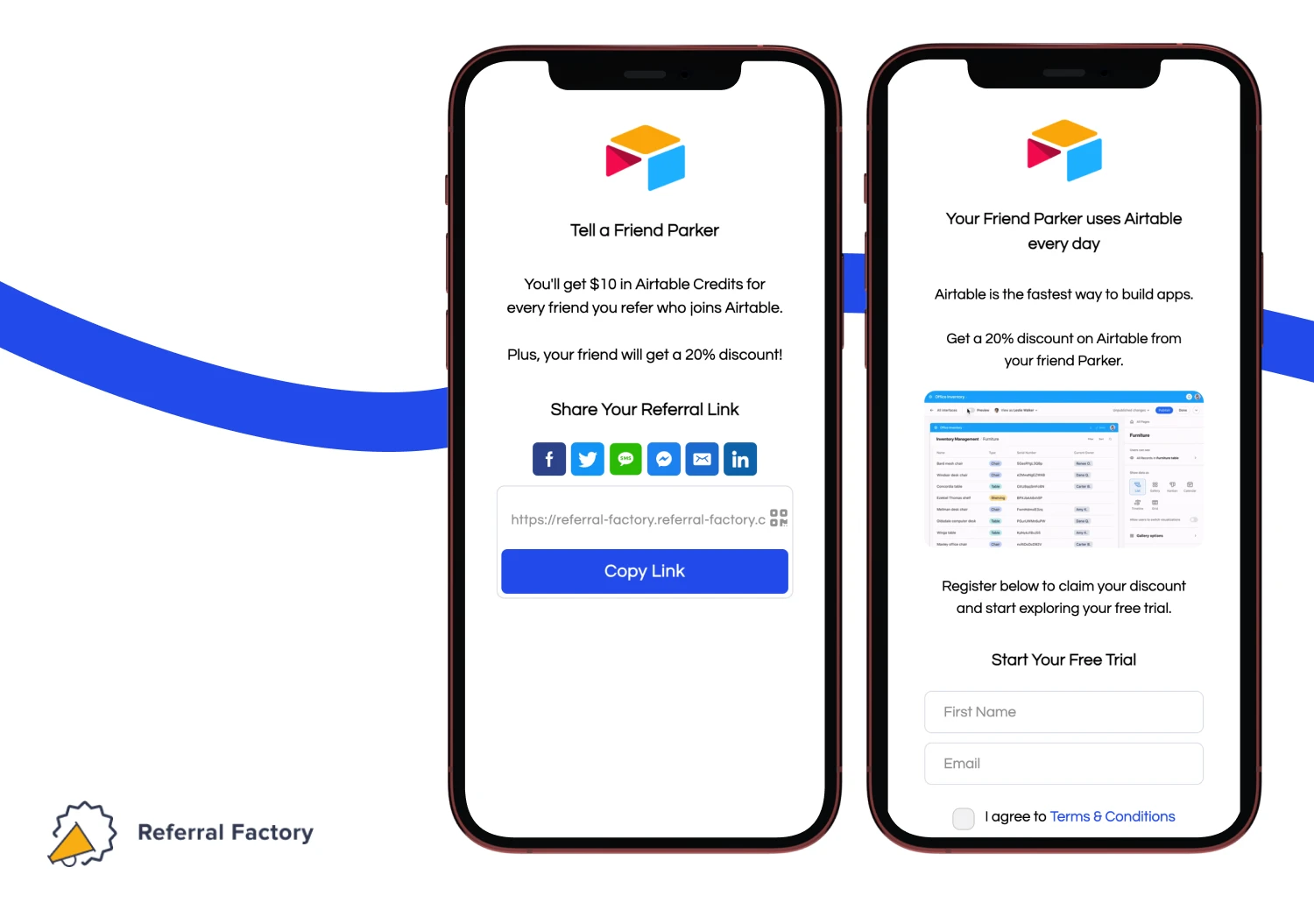
👉 Click here to use their referral program as a template.
Example #2: FreeAgent’s Give and Get 10% Forever Referral Program
FreeAgent is online accounting software made specifically for freelancers, small business owners, and their accountants. Every person who subscribes to FreeAgent using a unique referral link will get a 30-day free trial.
If they subscribe at the end of their trial, both the person referring and the person invited earn 10% off subscriptions for as long as they remain subscribed (i.e., forever).
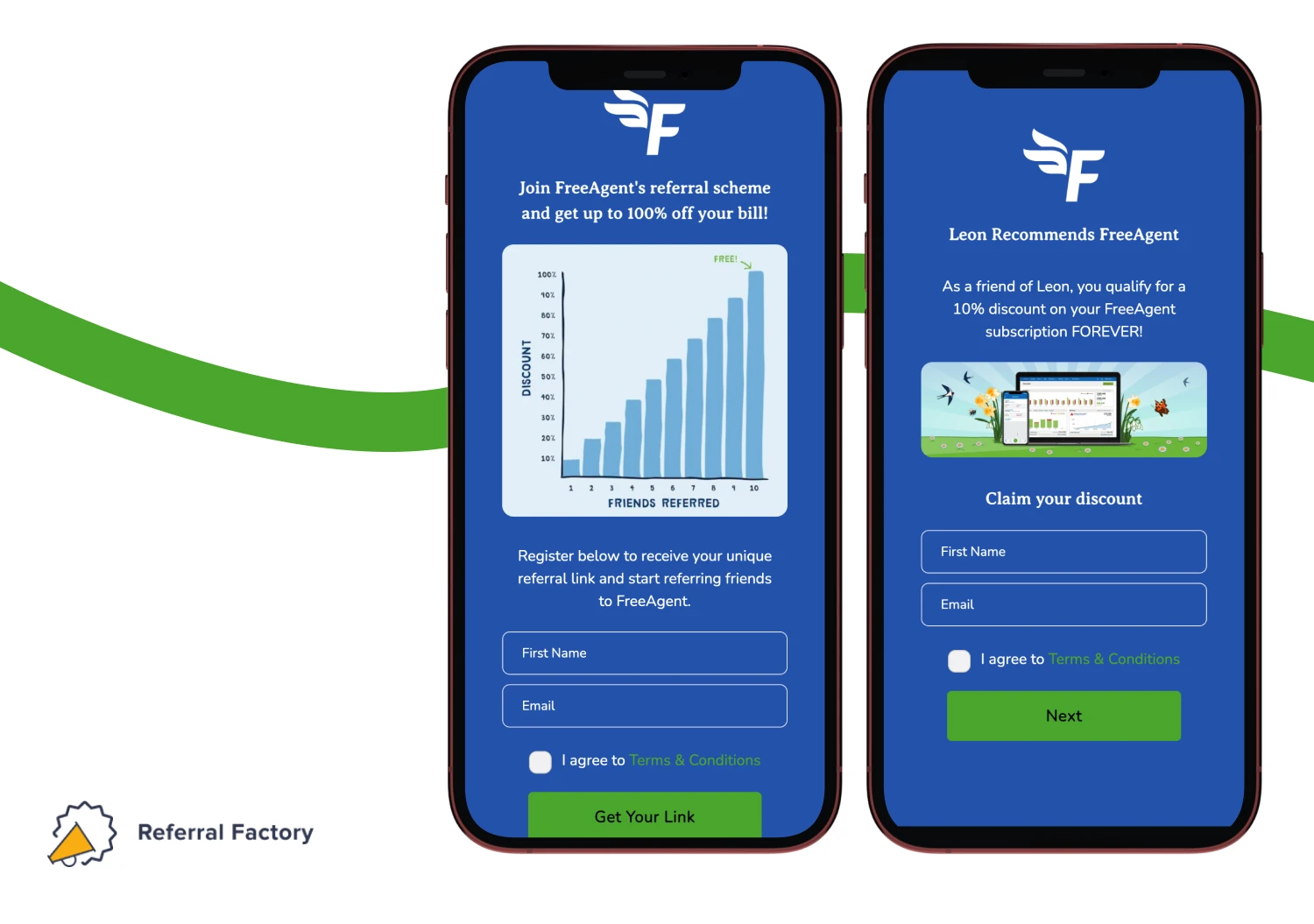
👉 Click here to use their referral program as a template.
Example #3: Expensify’s Give A Free Trial and Earn $250 Referral Program
Expensify is a platform that helps to manage your company’s spend — from receipt scanning and expense management to paying bills and making bookings.
Every time a person referring brings a new user into the platform, they will earn $250. And the new customers (their friends) can try the software for free.
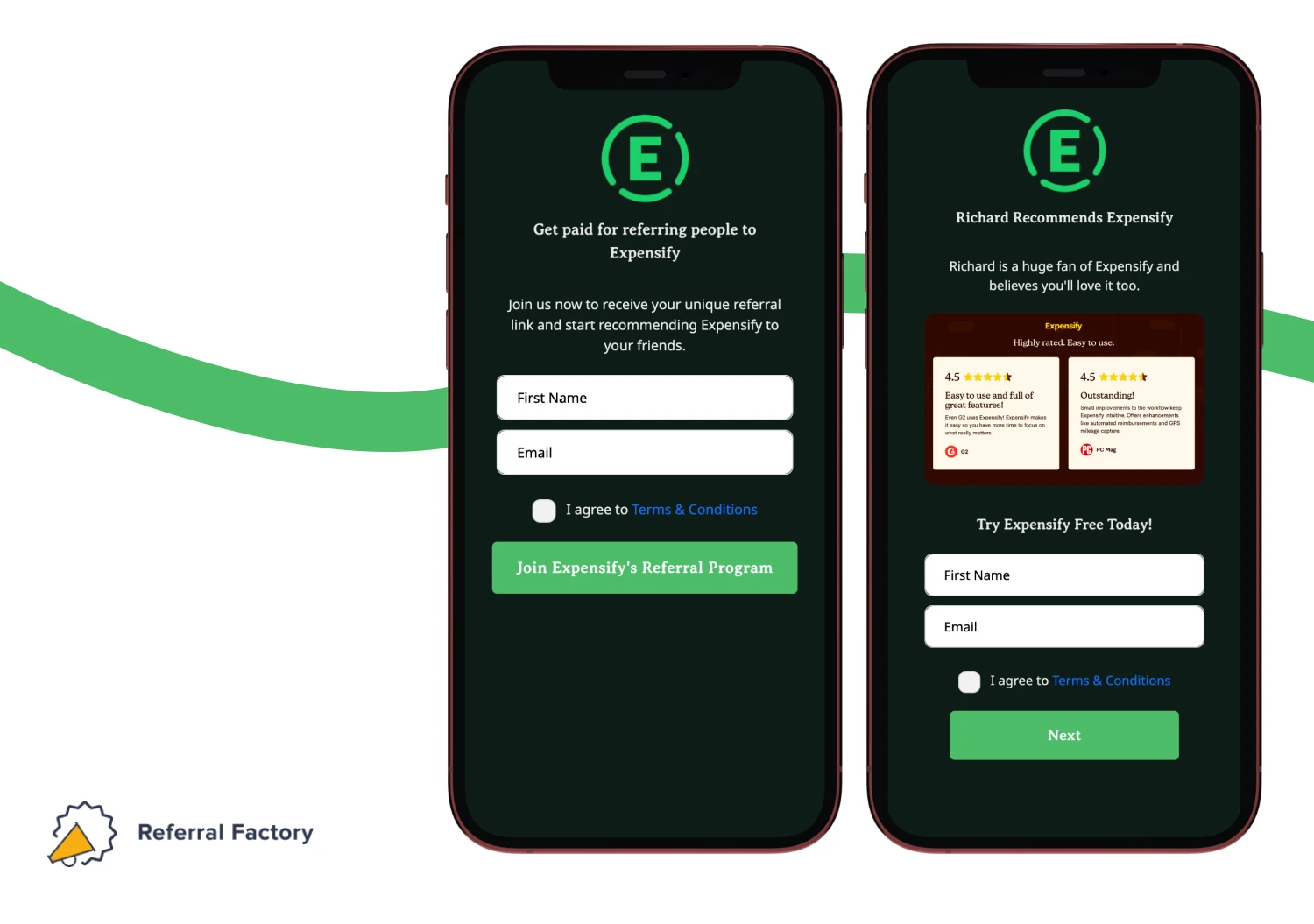
👉 Click here to use their referral program as a template.
Example #4: Fabletics VIP Double-Sided Referral Program
Fabletics is a clothing and accessories brand that offers a wide variety of high-quality and affordable activewear.
Users can refer friends to become VIP members and get $40 in store credit when they sign up using your unique link. At the same time, their friends get access to the 20-50% off everything.
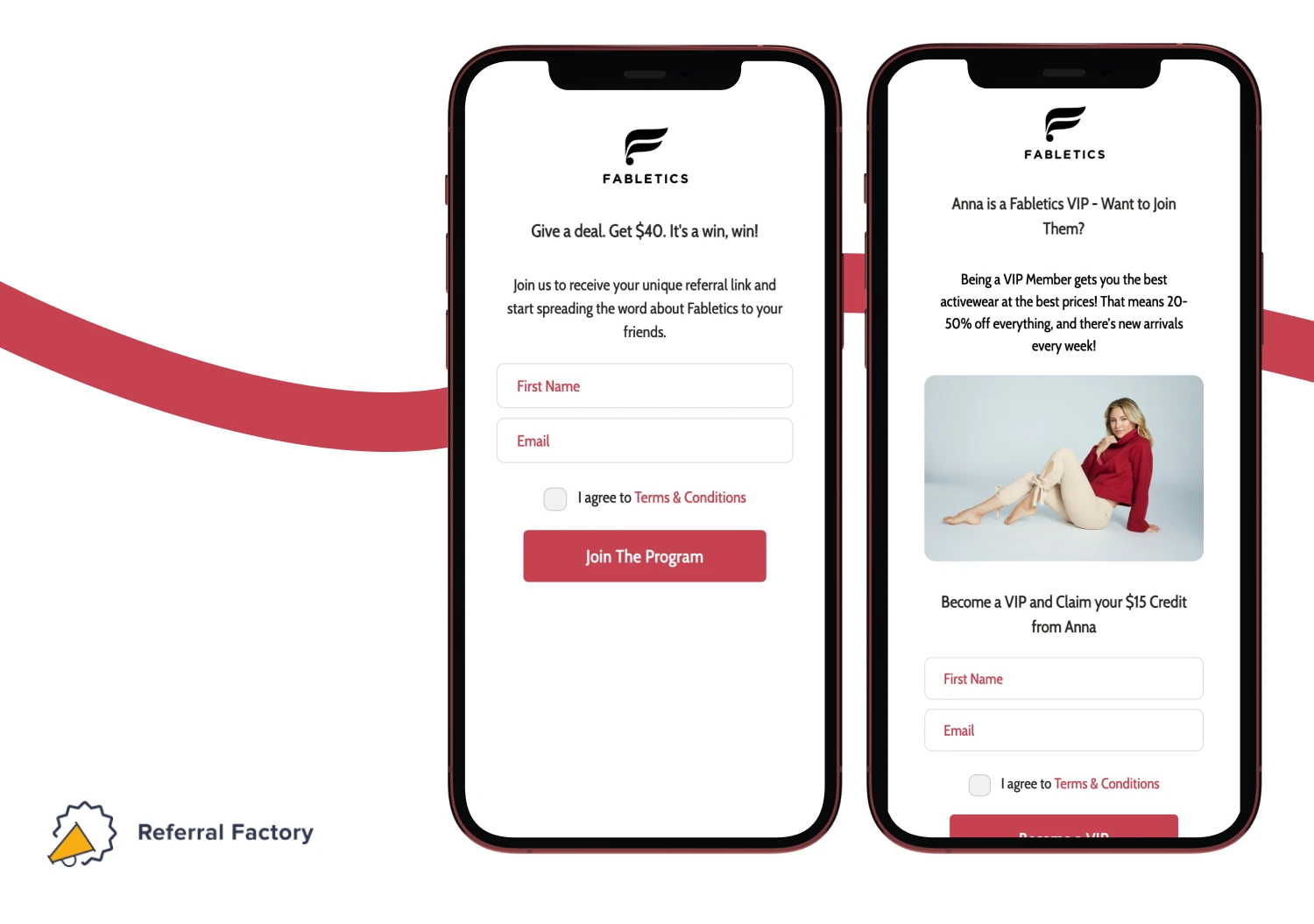
👉 Click here to use their referral program as a template.
In any case, a double-sided referral program creates a mutually beneficial cycle: referrers are incentivized to spread the word, referred friends are more likely to join, and businesses acquire new customers while strengthening existing relationships. Win-win-win!
What to Consider When Building a Double Sided Referral Program: 5 Key Tips
Crafting an effective double-sided referral program requires careful planning:
Tip #1️: Define Your Goals
What do you hope to achieve with your program? Increased sales, brand awareness, or customer engagement? Align your rewards and strategy with your goals, and create a campaign based on them. Remember that your referral program has to make sense financially.
Tip #2️: Choose Tangible Rewards
Your referral reward should be attractive and relevant to your target audience. If you offer something they don’t need, your program might be less successful. You can consider paying your existing and newly referred customers in your own currency (e.g., discounts, free trials, loyalty points, or exclusive content).
Nevertheless, keep in mind that a cash reward and vouchers tend to be more appealing to people. And remember that you know your customers best, so offer what they would really care about. And as two-sided referral incentives work the best, don’t forget about any of the participants when assigning rewards.
Tip #3️: Decide On A Conversion
One more thing to keep in mind – how do you define successful referrals? Those are the ones who convert. A conversion is basically the action your referral program participants do in exchange for the reward. The options might include anything from signing up for a newsletter to spending $X with you.
Tip #4️: Communicate Clearly
Ensure both the referrer and the newly referred customer understand the program details, terms, and how to claim their rewards. Complicated, unclear, or vague communication can make people give up on your referral program and quickly forget about it.
Tip #5️: Track and Analyze
Monitor your program’s performance and gather data on participation, reward redemption, and customer behavior. Use these insights to optimize your program over time.
To accomplish that, you will need a referral link and a proper referral program system in order to know who referred whom, what referred customers converted, and when to start rewarding customers.
How to Set Up a Double-Sided Referral Program with Referral Factory
Thanks to Referral Factory, making a referral program that works for both parties doesn’t have to be complicated. On the contrary – it is extremely easy.
You get a variety of subscription plans and ready-made referral program templates to help you jump-start your referral program effortlessly. You can also build a campaign from scratch! All you have to do is customize the design and copy to look 100% on-brand and spread the word about it.
Now, let’s go through the process of the referral program creation step-by-step.
Create A Double-Sided Referral Program: Step-By-Step
Step 1: Log in to your account (If you don’t have one, you can start a free 15-day trial here).
Step 2: Go to the Campaigns tab. There, you can choose to either build a referral program from scratch or a template.
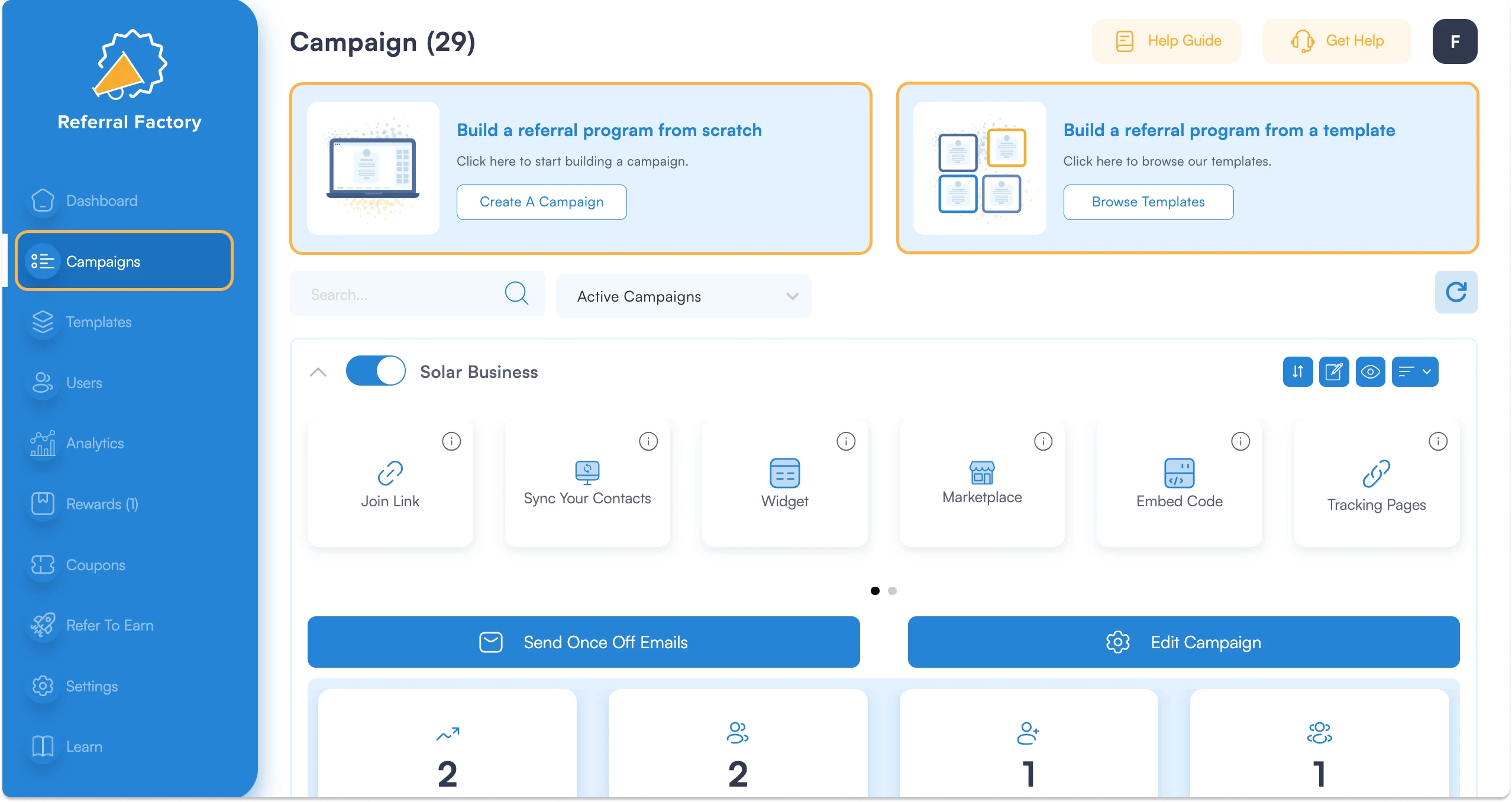
Step 3 / Option 1: If you want to build your campaign from scratch, click the Create A Campaign button.
Next, you will be asked to choose a Campaign Name and choose Campaign Language. You also have an option of switching a toggle on to get AI to help create your referral campaign.
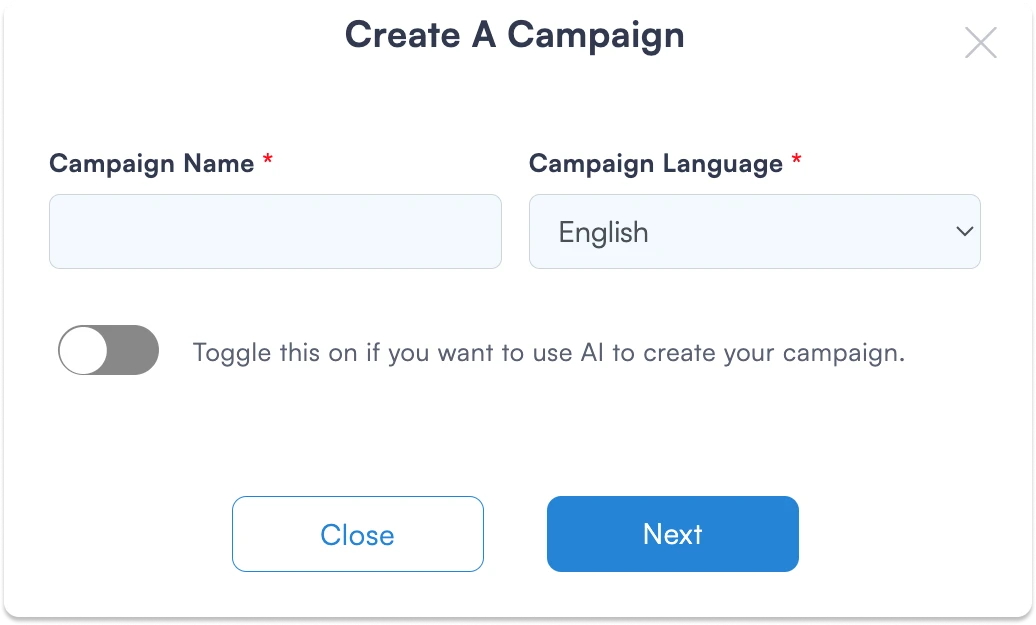
After clicking Next, you’ll move to the design stage. Upload your logo and choose a color palette. If you want to go one step further, go to Advanced settings to adjust your fonts, change the background, and modify the button.
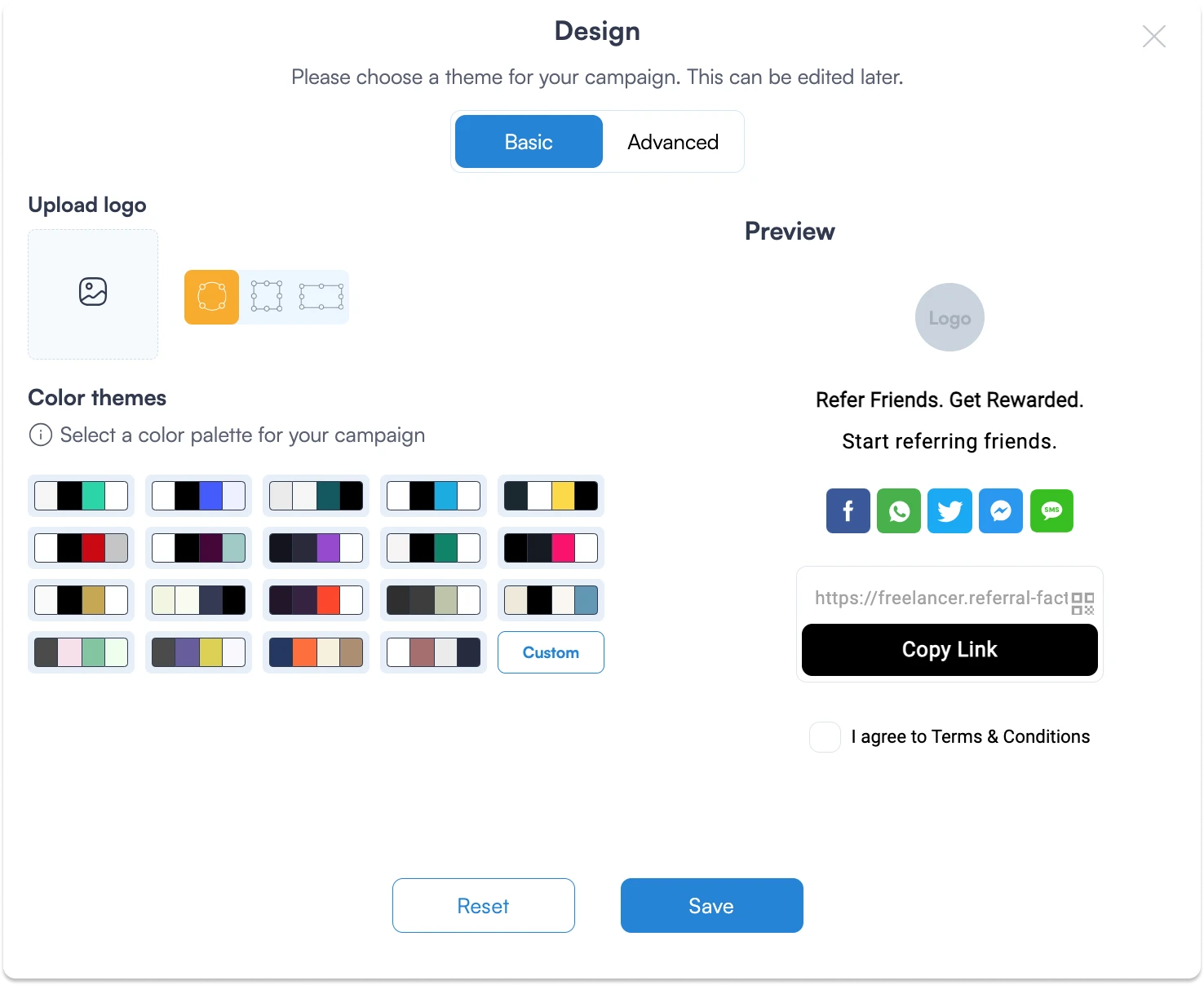
Step 3 / Option 2: If you want to build your campaign with a template, click Browse Templates.
You will be redirected to a page with a selection of templates for nearly any industry. Choose the one that fits your needs and click Use Template.
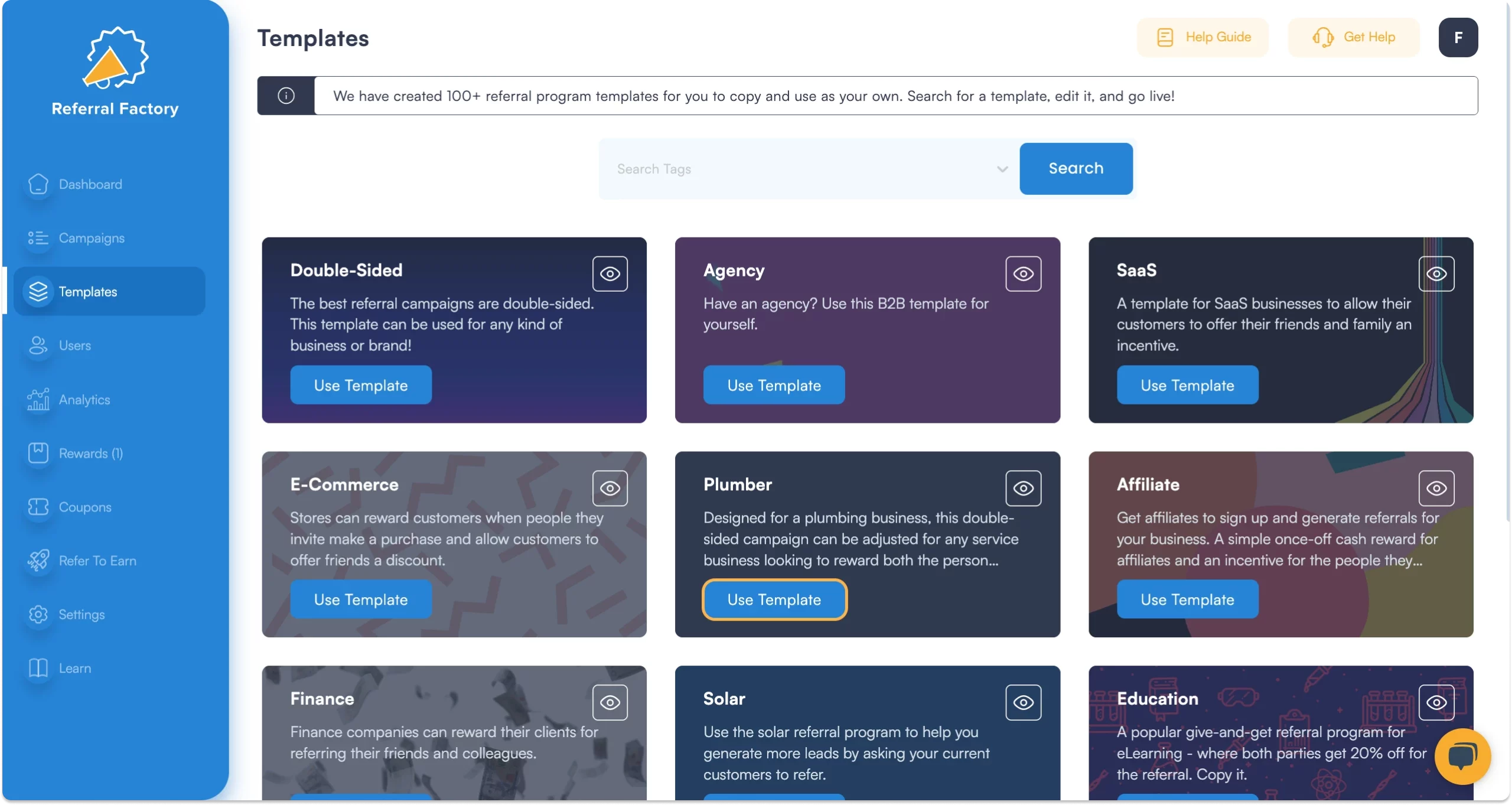
Next, you will be asked to write a Campaign Name and choose Campaign Language.
Step 4: Now, you will be redirected to the referral campaign builder (whether you’re building your referral program from scratch or with a template).

Here, you will have to go through the following steps:
-
- Create a Page for the Person Referring (Specify the conditions of your referral program for your current customers) IMPORTANT: These pages are optional! You can also enroll your customers in your referral program without them needing to register for their referral links.
-
- Create a Page for the Person Invited (Specify the conditions for the referred customers.)
-
- Settings (Set the details of your referral campaign – e.g., campaign’s start and end date, referral limits, etc.)
-
- Integrations (If needed, choose one of many integrations we offer, like Zapier, HubSpot, Stripe, Zoho, Salesforce, Pipedrive, etc. These help you to automate your referral program)
-
- Email Notifications (Set up the emails participants get when they interact with your referral program .)
-
- Promote Your Campaign (Choose any of the countless options to spread the word about your newly created referral program. For truly successful referral programs, we recommend using all the communication channels you have at your disposal.)
And you are done with setting up the campaign! That was easy, right?
Next, you will have to set up the rewards for each participant: one for the person referring and one for the person invited. But it will take just a moment, as you already have your referral campaign in place.
Set Up Automatic Rewards For The Person Referring And The Person Invited: Step-By-Step
Step 1: Go to the Rewards tab and click Add New Reward.
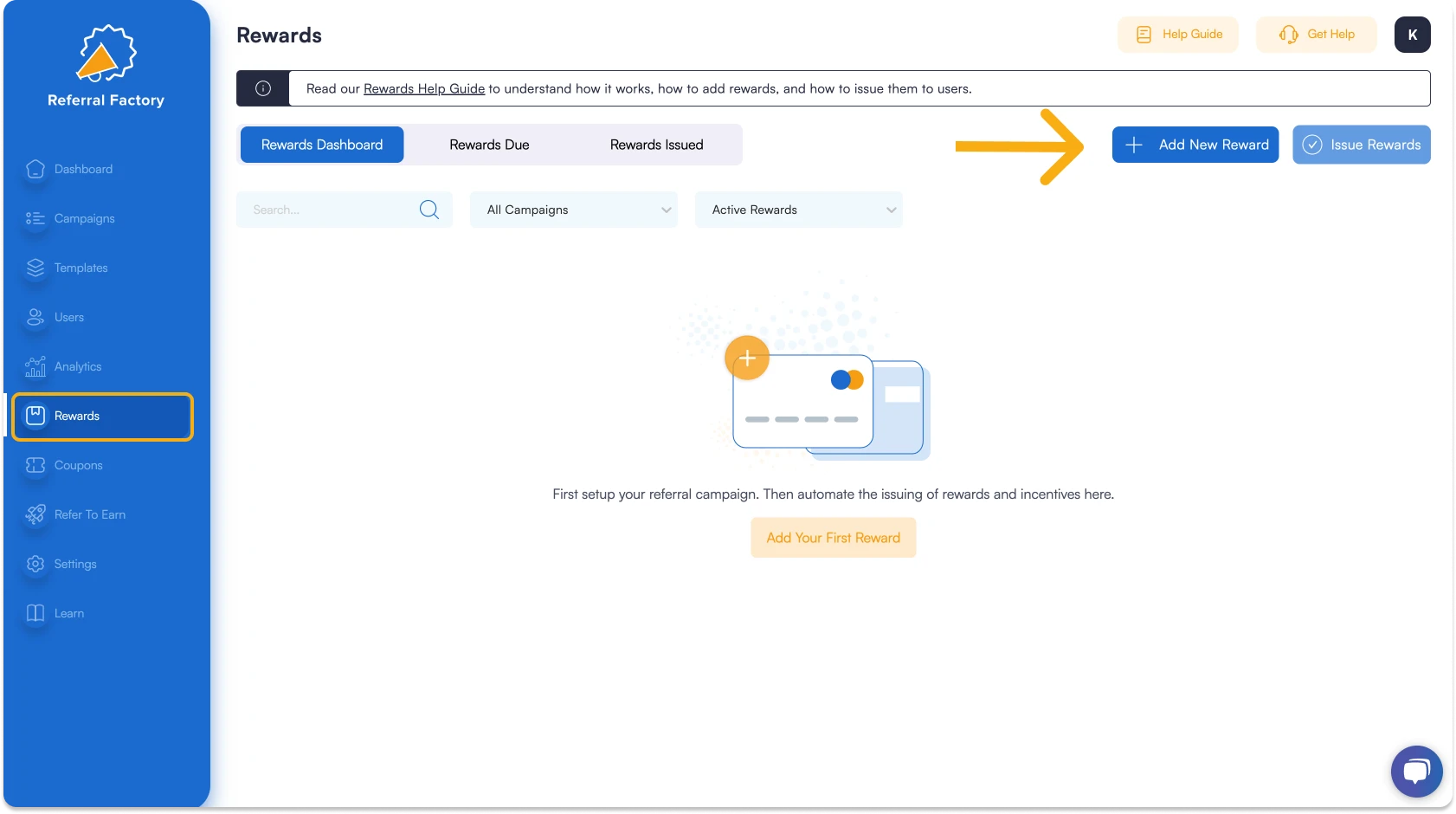
Step 2: Name your reward, connect it to your campaign, and select Person Referring (your existing client).
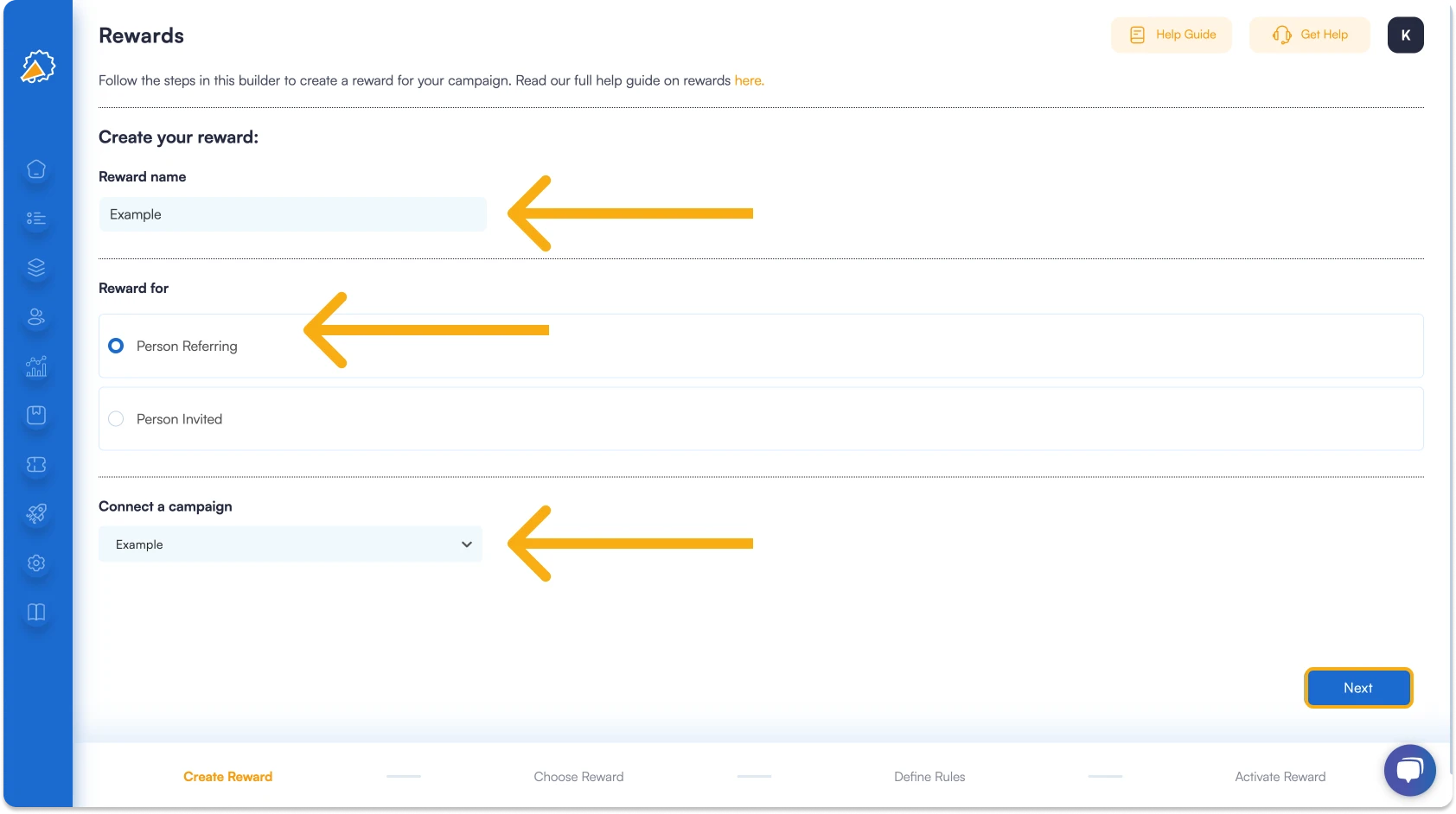
Step 3: Next, choose what reward you want to issue (Amazon gift cards, cash, Stripe credits, your own reward, etc.)
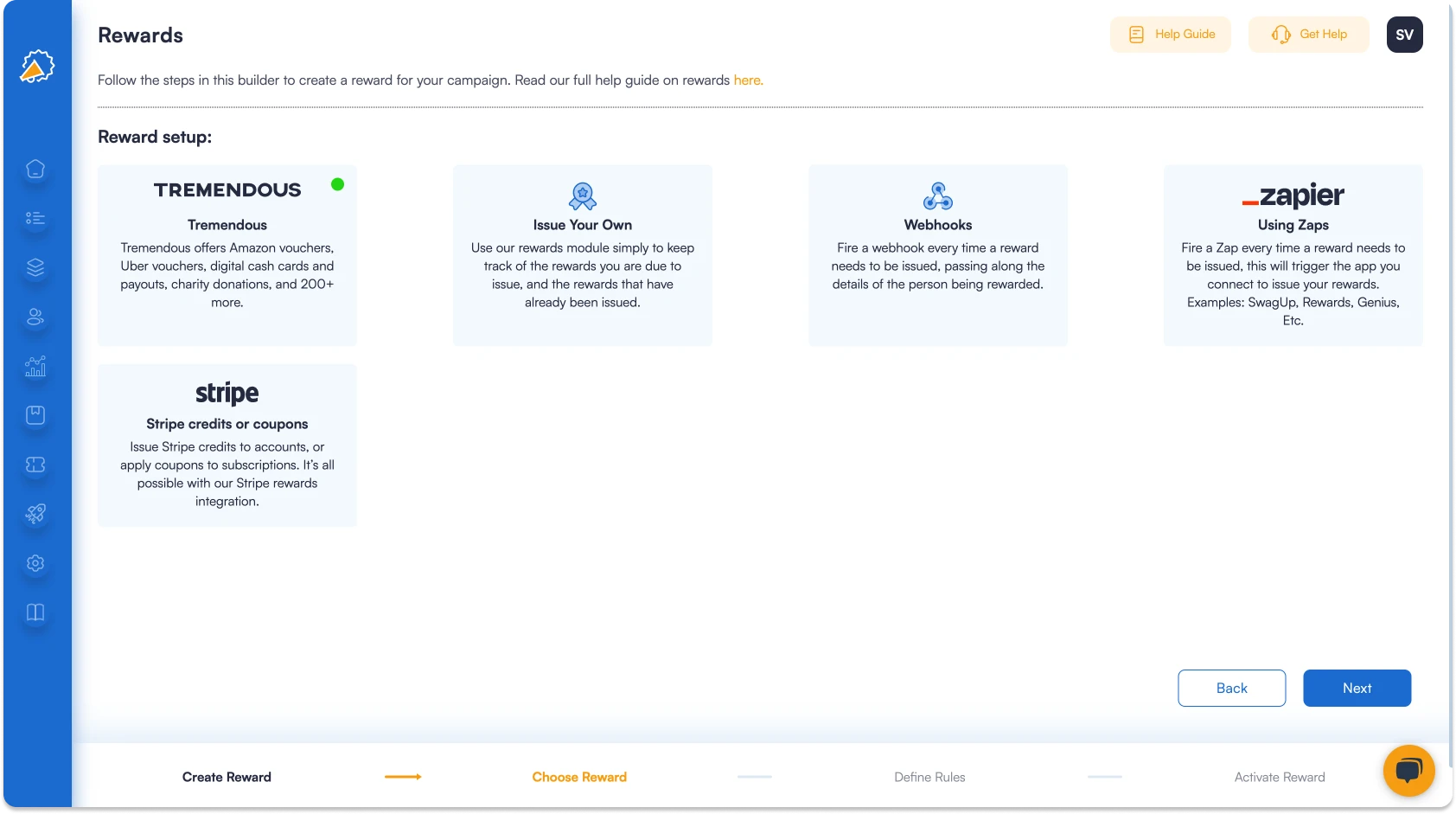
Step 4: Configure the rules for your reward (e.g., should it be fixed-value or a percentage of a sale, should they be once-off, milestone-based, or recurring).
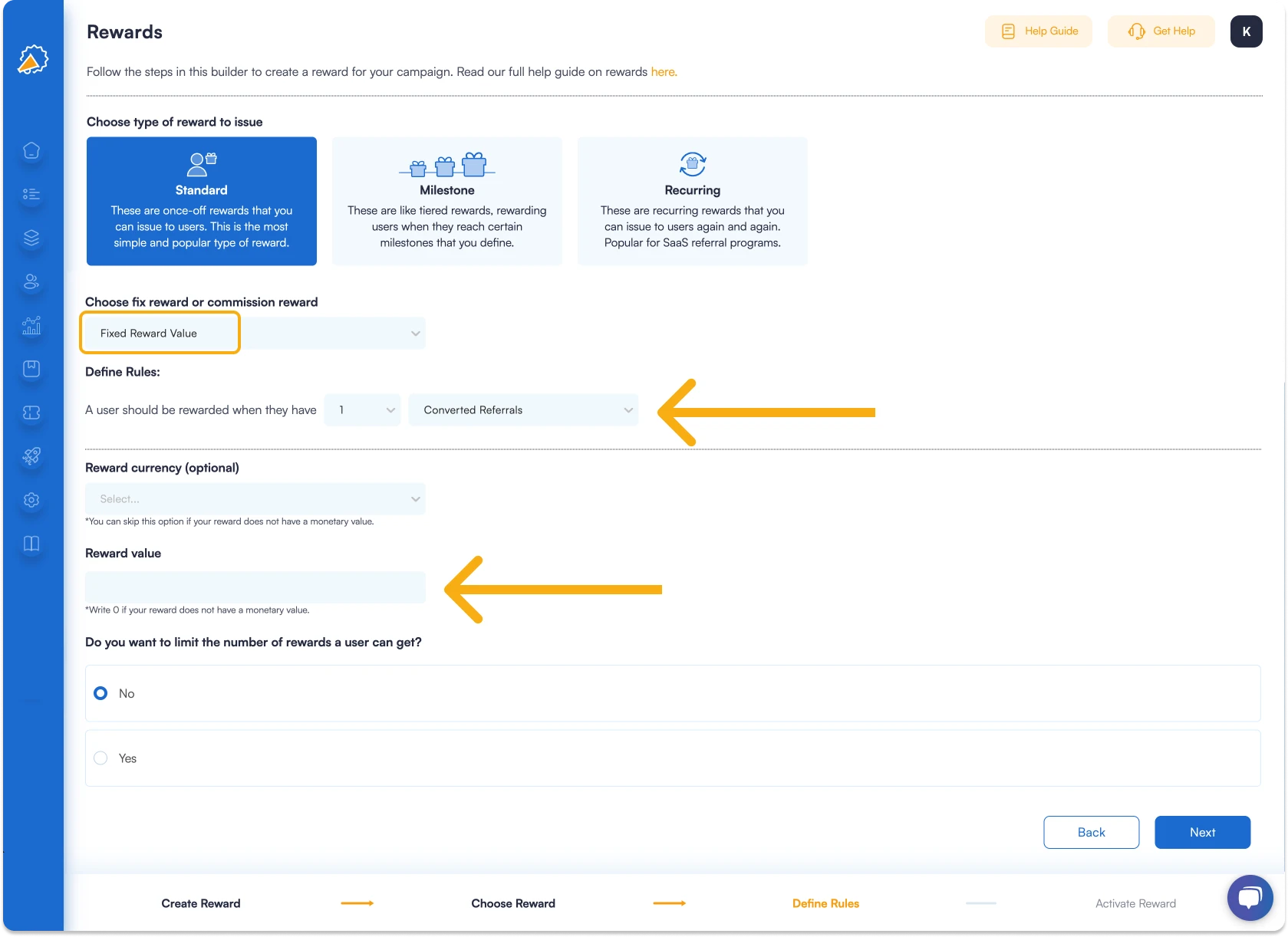
Step 5: Activate the reward.
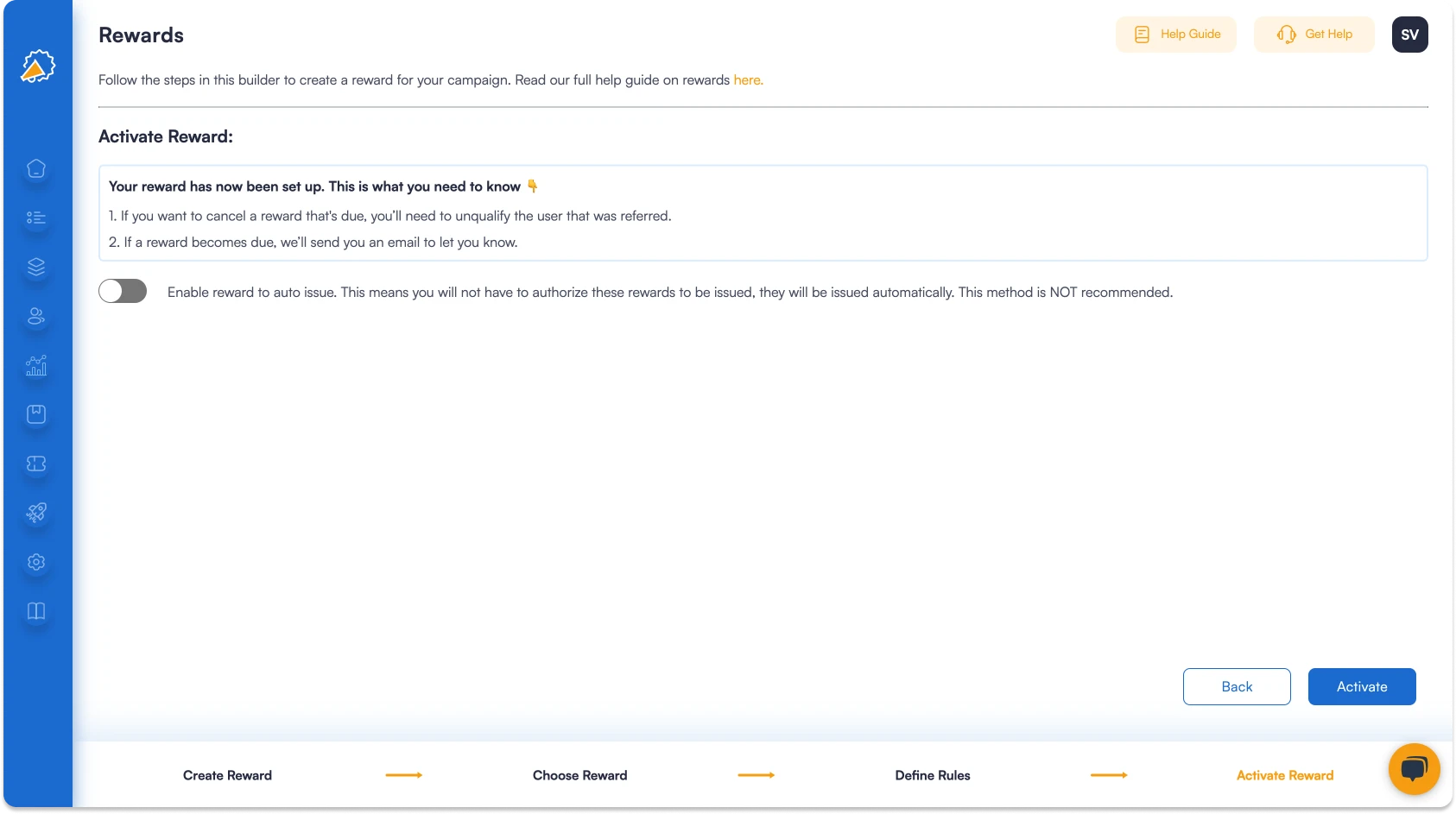
Step 6: Repeat Steps 1 through 5 for the Person Invited (your newly referred lead).
It’s as simple as that! When your newly referred lead converts, Referral Factory will automatically track who is due a reward and, depending on your configuration, can even automatically issue the reward for you.
For more details, have a look at this guide on how to add a reward.
Conclusion
While rewards are important, remember that giving back goes beyond just money. Make sure to genuinely thank people who refer others to your business and make it easy for them to use your services. Create a feeling of togetherness around your brand. This will help you build strong relationships that last and allow your business to grow steadily.


